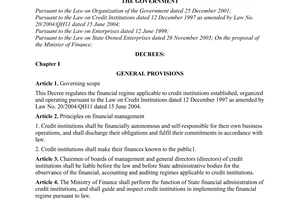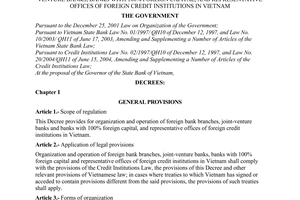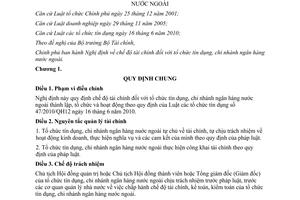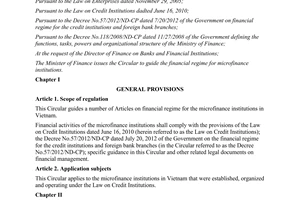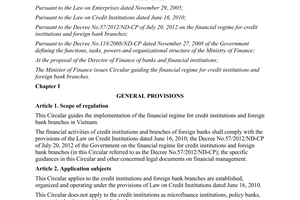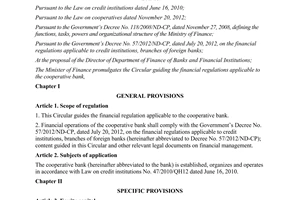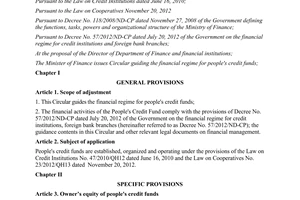Decree No. 57/2012/ND-CP on the financial regulations applicable to branches đã được thay thế bởi Decree 93/2017/ND-CP financial regime applicable to credit institutions branches of foreign banks và được áp dụng kể từ ngày 25/09/2017.
Nội dung toàn văn Decree No. 57/2012/ND-CP on the financial regulations applicable to branches
|
THE
GOVERNMENT |
THE
SOCIALIST REPUBLIC OF VIETNAM |
|
No. 57/2012/NĐ-CP |
Hanoi, July 20, 2012 |
DECREE
ON THE FINANCIAL REGULATIONS APPLICABLE TO BRANCHES OF FOREIGN BANKS
Pursuant to the Law on Government organization on December 25, 2001;
Pursuant to the Law on Enterprise on November 29, 2005;;
Pursuant to the Law on credit institutions on June 16, 2010;
At the proposal of the Minister of Finance,
The Government promulgates the Decree on the financial regulations applicable to branches of foreign banks.
Chapter 1.
GENERAL PROVISIONS
Article 1. Scope of regulation
This Decree prescribes the financial regulations applicable to branches of foreign banks and credit institutions established and operated under the Law on credit institutions No. 47/2010/QH12 on June 16, 2010.
Article 2. The principles of financial management
1. The branches of foreign banks and credit institutions exercising financial autonomy are responsible for their own operation, for the fulfillment of their obligations and commitments as prescribed by law.
2. Branches of foreign banks and credit institutions must make financial disclosures as prescribed by law.
Article 3. Responsibilities regulations
The President of the Board of Directors, or the President of the Member assembly, or the General Director (Director) of branches of foreign banks and credit institutions are responsible for before law and to State management agencies for the adherence to the accounting, audit and financial regulations of branches of foreign banks and credit institutions.
Chapter 2.
CAPITAL, ASSET MANAGEMENT AND USE
Article 4. Capital of credit institutions
1. Equity capital:
a) Charter capital;
b) The differences due to asset revaluation or exchange rate differences as prescribed by law;
c) Equity surplus
d) The charter capital reserve funds, professional development funds, financial reserve funds
dd) Undistributed profits;
e) Other capital legally possessed by branches of foreign banks and credit institutions.
2. Raised capital:
a) Capital raised from deposit of organizations and individuals;
b) Capital from investment authorization;
c) Loan from domestic and foreign credit institutions and financial institutions;
d) Loan from the State bank of Vietnam;
dd) Capital from the issuance of valuable papers.
3. Other kinds of capitals as prescribed by law
Article 5. Branches of foreign banks and credit institutions must sustain the actual value of the charter capital or the provided capital at least equal to the legal capital as prescribed by the Government. Branches of foreign banks and credit institutions must publicly announce the new charter capital or provided capital when the charter capital or provided capital is changed.
The actual value of the charter capital and provided capital are calculated by the actual contributed charter capital or provided capital plus (minus) the undistributed capital (unsettled loss), the funds extracted from post-tax profits (excluding commendation funds, welfare funds and reward funds of operation board).
Article 6. Utilization of capital and assets
1. Branches of foreign banks and credit institutions are entitled to use their capital for doing business under the Law on credit institutions on the principles of capital growth and adequacy.
2. Branches of foreign banks and credit institutions are entitled to change the structure of the capital and assets serving the business development.
3. Credit institutions are entitled to use no more than 50% of the charter capital and the charter capital reserve funds for building and purchasing fixed assets directly serving the operation and must adhere to the law provisions on construction and investment management.
The asset and capital mobilization among the branches or among the independent associate companies of a credit institution must comply with the Charter of the credit institution.
4. Branches of foreign banks are entitled to use no more than 50% of the provided capital and the provided capital reserve funds for building and purchasing fixed assets directly serving the operation and must adhere to the law provisions on construction and investment management.
Article 7. Contribution to credit institutions and purchasing shares of credit institutions
1. Credit institutions are only allowed to use their charter capital and reserve funds for contributing to and purchasing shares of other credit institutions or enterprises as prescribed by the Law on credit institutions.
2. The Shareholder general assembly, Board of Directors of credit institutions shall approve the contribution and the purchase of shares of other credit institutions or enterprises as prescribed by law and by its Charter.
3. The Member assembly of a credit institution being a limited liability company shall approve the contribution and the purchase of shares of other credit institutions or enterprises in accordance with law and its Charter.
4. A credit institution must not contribute to or purchase shares of other enterprises or credit institutions being its contributors.
Article 8. Capital adequacy assurance
Branches of foreign banks and credit institutions are responsible for implementing the provisions on capital adequacy assurance as follows:
1. Managing, using capital and assets in accordance with law.
2. Implementing the provisions on operational safety under the Law on credit institutions and other relevant law provisions.
3. Purchasing asset insurance in accordance with law.
4. Participating in deposit insurance and preservation as prescribed by law and announce the participation in deposit insurance and preservation at the head office and branches.
5. Recording to the expense on the business of loan loss reserve under the guidance of the State bank after obtaining the unanimous opinion from the Ministry of Finance.
6. Other measures for assuring the capital adequacy as prescribed by law.
Article 9. Asset inventory compilation and revaluation
1. Asset inventory compilation:
a) Branches of foreign banks and credit institutions must compile the inventory of their assets in the following cases:
- At the end of the fiscal year:
- Dividing, separating, merging and consolidating and transforming the legal form;
- After the occurrence of a natural disaster or enemy sabotage or some event that cause fluctuation of the assets of branches of foreign banks and credit institutions;
- At the request from competent State agencies.
b) The reasons for and people in charge of the lack or the excess of assets must be identified and settled.
2. Asset revaluation:
a) Branches of foreign banks and credit institutions must revaluate their assets in the following cases:
- At the request from competent State agencies.
- Transforming the legal existence, diversifying the ownership;
- Making external investment from the assets;
- Recalling the assets after the suspension of the external investment;
- Other cases as prescribed by law
b) The revaluation of assets and accounting of the increased or decreased value due to the asset revaluation specified in Point a Clause 2 this Article must comply with law provisions depending on each specific cases.
Article 10. Fixed assets depreciation
Branches of foreign banks and credit institutions must calculate the fixed asset depreciation as prescribed by law provisions on enterprises. Branches of foreign banks and credit institutions are entitled to use the capital from the fixed asset depreciation for reinvesting in the replacement of fixed assets and in other business purposes as prescribed by law.
Article 11. Asset loss settlement
Branches of foreign banks and credit institutions must identify the reasons and responsibilities for the loss of assets as follows:
1. The person that causes the asset loss must pay compensation. The President of the Board of Directors, or the President of the Member assembly, or the General Director (Director) of branches of foreign banks and credit institutions shall determine the compensation levels as prescribed by law and bear responsibilities for their decisions.
2. Settle the loss in accordance with the insurance contract for insured assets.
3. Using the reserve fund extracted from the expenses to cover the loss as prescribed by law.
4. The deficient value of the loss after covered by the compensation from individuals, organizations the insurer and the provisions extracted from the expenses shall be covered by the financial reserve funds of branches of foreign banks and credit institutions. If the financial reserve fund cannot cover, the deficient amount shall be recorded as other expenses in the period.
Article 12. Leasing, mortgaging and pawning assets.
Branches of foreign banks and credit institutions are entitled to lease out, mortgage and pawn their assets as prescribed by law in a way that assures the capital adequacy, efficiency and capital growth.
Article 13. Selling assets
1. Branches of foreign banks and credit institutions are entitled to sell their assets in order to recover the capital and ensure the business efficiency.
2. The asset sale of branches of foreign banks and credit institutions must comply with law and their Charter.
3. The asset sale of credit institutions being State-owned one-member limited liability companies must comply with law provisions on asset sale applicable to State-owned one-member limited liability companies.
Article 14. Asset liquidation
1. Branches of foreign banks and credit institutions are entitled to liquidate assets of inferior quality, damaged assets unable to be restored; technically backward assets not being used or not being efficiently used that cannot be sold as intact items; assets unable to be used after their use terms expire.
The authority to make decisions on liquidating assets of credit institutions being State-owned one-member limited liability companies must comply with law provisions on asset liquidation applicable to State-owned one-member limited liability companies.
The authority to make decisions on liquidating assets of other branches of foreign banks and credit institutions must comply with law and their Charter.
2. The Liquidation council must be establish when liquidating assets of branches of foreign banks and credit institutions. For assets required to be put up for auction when liquidated, branches of foreign banks and credit institutions must hold auctions as prescribed by law.
Chapter 3.
RECEIPTS AND EXPENSES
Article 15. Receipts
1. Receipts from the business of branches of foreign banks and credit institutions include:
a) Receipts from the business, including:
- Receipts from credit activities: deposit interest, loan interest, financial lease interest and other credit activities;
- Receipts from services:
- Receipts from trading foreign currency and gold;
- Receipts from contribution interest and share purchase of shares;
- Receipts from exchange rates differences;
- Receipts from other business.
b) Other receipts, including:
- Receipts from fixed asset sale and liquidation;
- Receipts from the capital settled by loss reserve funds;
- Other receipts.
2. The Ministry of Finance shall specify the conditions and time for receipt calculation.
Article 16. Expenses
1. The expenses of branches of foreign banks and credit institutions are the actual expenses on the business of branches of foreign banks and credit institutions, including:
- Expenses on credit activities: paying deposit interest, paying loan interest, and other expenses credit activities;
- Expenses on services provision;
- Expenses on the trading of foreign currency and gold;
- Expenses on contribution and purchase of shares;
- Expenses on exchange rates differences;
- Expenses on other business activities;
- Expenses on tax payment and other payment of fees and charges;
- Expenses on assets include: fixed asset depreciation, expenses on asset lease, expenses on asset repair and maintenance; purchase of tools and devices; purchase of asset insurance;
- Expenses on employees: salaries, remunerations; other contributed by salary: social insurance, medical insurance, unemployment insurance, accident insurance, expenses on the Union; expenses on meals, labor protection; expenses on uniforms and other payment to employees as prescribed by law;
- Expenses on the management: expenses on electricity, water, telephone, materials, papers, stationery; expenses on consultancy, audit; commission payment, expenses on intermediary agents; expenses on hiring experts at home and overseas; expenses on scientific and technological innovation researches, expenses on training; rewards for initiatives that improve productivity, rewards for cost reduction; expenses on environment protection; expenses on propagation, advertisements, marketing, promotion; expenses on conventions, reception, transactions, foreign affairs and other expenses;
- Expenses on loan loss reserve, deposit insurance and preservation;
- Other expenses: expenses on professional association fees that branches of foreign banks and credit institutions participate in; expenses on the Communist activities in branches of foreign banks and credit institutions (the expenses outside the budget of the Communist organizations); expenses on the sale and liquidation of assets or the remaining value of the sold or liquidated fixed assets (if any); expenses on the recovery of the debts written off, expenses on the collection of bad debts; expenses on the asset loss remaining after being covered by the sources specified in Clause 4 Article 11 of this Decree; expenses on the recorded receipts unable to be collected actually; expenses on social activities as prescribed by law; and other expenses.
2. The Ministry of Finance, the State bank of Vietnam shall elaborate some particular expenses of branches of foreign banks and credit institutions.
Article 17. The payments that must not be recorded as expenses
Branches of foreign banks and credit institutions must not record the following payments as expenses:
1. The fines for administrative violations, including: violations of traffic laws, violations of business registration regulations, violations of statistical accounting regulations, violations of tax laws and other administrative violations as prescribed by law.
2. The payments irrelevant to the business of branches of foreign banks and credit institutions.
3. The payments without valid receipts.
4. The payment defrayed by other budgets.
Article 18. The currency
1. The economic activities must be recorded into books, Financial statements and settled in Vietnam dong (VND).
2. Accounting units primarily spending and receiving in foreign currencies are allowed to select one foreign currency decided by the Ministry of Finance to make accounting books and Financial statements.
Article 19. branches of foreign banks and credit institutions must record the receipts and expenses in accordance with law and bear responsibilities before law for their accuracy and comply with the regulations on accounting invoices and receipts.
Chapter 4.
PROFITS AND FUNDS
Article 20. Incomes subject to enterprise income tax
The incomes subject to enterprise income tax of branches of foreign banks and credit institutions must comply with law provisions on enterprise income tax.
Article 21. Profits after enterprise income tax
The profits after enterprise income tax of branches of foreign banks and credit institutions are the differences calculated by the total receipt minus the necessary expenses in the same period including enterprise income tax.
Article 22. Distribution of profits after enterprise income tax applicable to credit institutions being State-owned one-member limited liability companies
1. Distributing profits to the contributors under the contract (if any).
2. The expired loss recovery in the previous years shall be deducted from the profits before enterprise income tax.
3. Extracting 5% into the charter capital accumulation reserve fund. This fund must not exceed the charter capital of the credit institution.
4. Extracting 10% into the financial reserve fund. This fund must not exceed 25% the charter capital of the credit institution.
5. The profit after deducting the amount specified in Clause 1, 2, 3, and 4 this Article are distributed as follows:
a) Extracting 50% into the professional development fund;
b) Establishing the reward funds for the management board of the credit institution in accordance with the provisions applicable to State-owned one-member limited liability companies;
c) Extracting from no more than 3-month salary of the employee into the welfare and reward fund;
d) The remaining profit after deducting the amount specified in Point a, b, c this Clause shall be transferred to the professional development fund.
Article 23. Distribution of profits after enterprise income tax applicable to other branches of foreign banks and credit institutions
1. Distributing profits to the contributors under the contract (if any).
2. The expired loss recovery in the previous years shall be deducted from the profits before enterprise income tax.
3. Extracting 5% into the charter capital accumulation reserve fund of the credit institution or into the provided capital accumulation reserve fund of the branches of foreign banks. These funds must not exceed the charter capital of the credit institution or the provided capital of the branches of foreign banks.
4. Extracting 10% into the financial reserve funds. The balance of these funds must not exceed 25% of the charter capital of the credit institution or 25% of the provided capital of the branches of foreign banks.
5. The distribution of the remaining profit shall be decided independently by branches of foreign banks and credit institutions. For credit institutions being joint-stock commercial banks of which 50% of the charter capital is owned by the State, the representative of the State-owned capital at the bank must obtain the opinion from the State bank of Vietnam and concur with the Ministry of Finance in the distribution of the remaining profits to vote at the Shareholder general assembly.
Article 24. The principles of using funds
1. The accumulation reserve funds of the charter capital and provided capital are used for accumulating the charter capital and provided capital.
2. The financial reserve fund is used for covering the remaining loss and damage of assets during the business of after being covered by compensation from the organizations and individuals that causes such loss, from the indemnity from the insurer, and from the reserve fund extracted from the expenses; and used for other purposes as prescribed by law.
3. The professional development fund is used for investing in expanding the business scale, innovating the technology and improving the work conditions of the credit institution.
Depending on the demand for investment and capability of the fund, the credit institution shall decide the form and method of investment on the principles of efficiency, safety and capital growth.
4. The reward fund is used for rewarding the Member assembly and management board of the credit institution. The reward levels are decided by the owner consistently with the business efficiency of the credit institution at the proposal of the President of the Member assembly of the credit institution.
5. The reward fund is used for:
a) Giving annual rewards or periodic rewards for officers and employees of the credit institution. The reward levels are decided by the Member assembly of the credit institution at the proposal of the General Director (or Director) and the Union of the credit institution consistently with the productivity and work results of their employees.
b) Giving irregular rewards for individuals or collectives in the credit institution that introduce initiatives to improve the techniques and professional process that enhance business efficiency. The reward levels are decided by the Member assembly of the credit institution;
c) Giving rewards to individuals and units outside the credit institution economically involved that completely fulfill the contractual conditions and efficiently contribute to the business of the credit institution. The reward levels are decided by the Member assembly of the credit institution.
6. The welfare fund is used for:
a) Investing in building, repairing welfare constructions of the credit institution, contributing to the investment in the common welfare constructions of the industry, or of other units contractually.
b) Spending on cultural, sports activities and public welfare of the staff of the credit institution;
c) Spending on the regular or irregular support for the officers and employees in difficulties of the credit institution, including the retired or disabled ones;
d) Spending on other welfare activities.
The Member assembly, General Director (or Director) of the credit institution shall cooperate with the Executive board of the internal Union in managing and using this fund.
Chapter 5.
AUDIT, STATISTICS AND ACCOUNTING REGULATIONS
Article 25. Accounting and statistics
1. Branches of foreign banks and credit institutions must comply with the regulations on accounting and statistics as prescribed by law.
2. The fiscal year of branches of foreign banks and credit institutions starts on January 01 and ends on December 31.
Article 26. Report regulations
At the end of the accounting period (quarterly or annually), the branches of foreign banks and credit institutions must make and send the statistics and Financial statements as prescribed by law. The President of the Board of Directors, or the President of the Member assembly, or the General Director (Director) of branches of foreign banks and credit institutions must be responsible for accuracy of those reports.
Article 27. Audit
1. Credit institutions must organize internal audits as prescribed in Article 41 of the Law on credit institutions.
2. The Financial statement audit of branches of foreign banks and credit institutions comply with current law provisions on accounting and audit. The Financial statement audit results of credit institutions must be sent to the Ministry of Finance and the State bank of Vietnam.
Article 28. Disclosure of Financial statements
Within 120 days as from the end of the fiscal year, the branches of foreign banks and credit institutions must disclose their Financial statements as prescribed by law.
Article 29. Financial regimes
Based on the documents guiding the financial regulations, credit institutions shall formulate and submit their financial regimes to the Board of Directors and Member assembly for approval.
Article 30. Financial plans
1. For credit institutions being commercial banks of which 100% of the charter capital is owned by the State or joint-stock commercial banks of which 50% of the charter capital is owned by the State must formulate the annual financial plans under the guidance from the Ministry of Finance. The financial plans of credit institutions include:
a) The plan on capital sources and on the use of capital sources of the credit institution;
b) The plan on receipts, expenses, business results and the State budget payment of the credit institution;
c) The plan on labor and salaries of the credit institution.
The plans stated above must be approved by the Board of Directors, Member assembly of the credit institution and must be sent to the Ministry of Finance and the State bank of Vietnam before November 15th of the year before the planned year.
2. For other branches of foreign banks and credit institutions, the formulation of financial plans must comply with their charter.
Chapter 6.
RESPONSIBILITIES OF THE BOARD OF DIRECTORS, OR THE MEMBER ASSEMBLY, THE GENERAL DIRECTOR, DIRECTOR OF BRANCHES OF FOREIGN BANKS AND CREDIT INSTITUTIONS
Article 31. Responsibilities of the Board of Directors and the Member assembly of the credit institution.
1. Inspecting and supervising the financial activities of the credit institution within the authority prescribed by law.
2. Receiving capital, land, natural resources and other resources provided by the State, the owner and the contributors.
3. Making decisions or approvals within the authority prescribed by law and by the charter of the credit institution:
a) The plan on capital mobilization
b) The plan on using, preserving and growing capital, the projects of investment and asset trading of the credit institution; the plans on the contribution and purchase of shares from other credit institutions and enterprises;
c) The annual Financial statements and long-term financial plans, annual financial plans of the credit institution;
d) The annual Financial statements of independent associate companies affiliated to the credit institution;
dd) Appointing representatives of the capital invested in other enterprises.
4. Disclosing the Financial statements as prescribed.
5. Inspecting, supervising the General Director (Director) of the credit institution, the Directors of the independent associate companies with regard to the capital use, preservation and growth; Implementing the approve business plans; fulfilling the State budget obligations.
6. Being responsible for the accuracy of the Financial statements.
7. Performing other duties as prescribed by law.
Article 32. Responsibilities of General Director (Director) of the credit institution
1. Operating the credit institution and responsible to the Board of Directors, Member assembly, and before law for the operation of the credit institution.
2. In charge of the capital use in business consistently with the plans on using, preserving and growing capital approved by Board of Directors and Member assembly; implementing the plans on profit distribution after fulfilling the tax liability and other financial obligations prescribed by law.
3. Being responsible for the mobilization and use of capital in business; being responsible for the damage caused by subjective mistakes.
4. Establishing the expense norms consistently with the business condition of the credit institution.
5. Making and submitting the Financial statements to Board of Directors and Member assembly for approval and being responsible for the accuracy of the Financial statements, statistics and other financial information.
6. Formulating and submitting annual financial plans consistently with the business plan to the Board of Directors and Member assembly for approval.
7. Making decisions on the projects of investment, contribution, purchases of shares from other credit institutions and enterprises under the authorization of the Board of Directors and Member assembly of the credit institution.
8. Performing other duties as prescribed by law.
Article 33. Responsibilities of General Directors (Directors) of branches of foreign banks
1. Representing the branches of foreign banks before law, bearing responsibilities for every activity and daily operation of branches of foreign banks within the rights and obligations in accordance with current law provisions.
2. In case one foreign bank has two or more branches in Vietnam and exercise the uniform report, accounting and financial regulations, the foreign bank must authorize a General Director (Director) of the branch to be responsible before law for every activity of the branches of the foreign bank in Vietnam.
Chapter 7.
RESPONSIBILITIES OF MANAGEMENT AGENCIES
Article 34. Responsibilities of the Ministry of Finance
1. Guiding branches of foreign banks and credit institutions to comply with the financial regulations prescribed by this Decree.
2. Inspecting the adherence to financial regulations of the credit institution as prescribed by law provisions on inspection.
3. Cooperating with the State bank of Vietnam to handle the financial issues of credit institutions being State-owned one-member limited liability companies and credit institutions being joint-stock commercial banks of which 50% of the charter capital is owned by the State.
Article 35. Responsibilities of the State bank of Vietnam
1. Inspecting, supervising the comprehensive operation of the branches of foreign banks and credit institutions; quarterly and annually sending reports on the financial status and violations of financial regulations of branches of foreign banks and credit institutions to the Ministry of Finance for prompt settlement.
2. Performing the functions of the representatives of the State-owned capital at the credit institutions of which the capital is provided by the State.
a) Making decisions and being responsible for their decisions within the authority of a representative of the State-owned capital as prescribed by law;
b) Being in charge and cooperating with the Ministry of Finance to present the financial issues ultra vires to the Prime Minister.
Chapter 8.
IMPLEMENTATION PROVISIONS
Article 36. Effect
1. This Decree takes effect on September 15, 2012.
2. This Decree supersedes the Government's Decree No. 146/2005/NĐ-CP on November 23, 2005 on the financial regulations applicable to credit institutions and the provisions on financial regulations of branches of foreign banks in the Government's Decree No. 22/2006/NĐ-CP on February 28, 2006 on the organization and operation of branches of foreign banks, joint-ventures banks, 100%-capitalized banks, and representative offices of foreign credit institutions in Vietnam.
Article 37. The Ministry of Finance is in charge and shall cooperate with the State bank of Vietnam to guide the implementation of this Decree.
Ministers, Heads of ministerial-level agencies, Heads of Governmental agencies, the Presidents of People’s Committees of central-affiliated cities and provinces are responsible for the implementation of this Decree.
|
|
FOR
THE GOVERNMENT |
------------------------------------------------------------------------------------------------------
This translation is made by LawSoft and
for reference purposes only. Its copyright is owned by LawSoft
and protected under Clause 2, Article 14 of the Law on Intellectual Property.Your comments are always welcomed

